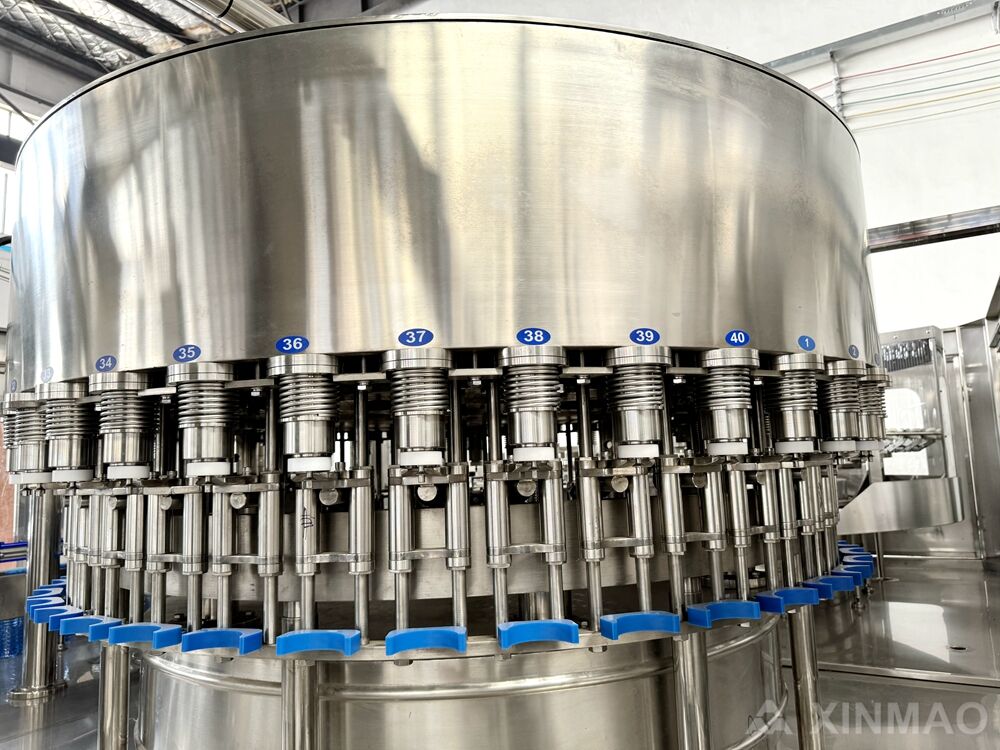หลักการพื้นฐานเกี่ยวกับการบรรจุที่สะอาดในกระบวนการผลิตน้ำดื่ม
เหตุใดการบรรจุที่สะอาดจึงสำคัญต่อความปลอดภัยของผู้บริโภค
การรักษาความสะอาดระหว่างกระบวนการเติมน้ำในโรงงานผลิตน้ำดื่มช่วยป้องกันการปนเปื้อนที่ก่อให้เกิดโรคที่ติดต่อทางน้ำ การวิจัยจากองค์กรด้านสาธารณสุขชี้ให้เห็นว่าเมื่อผู้ผลิตน้ำไม่ปฏิบัติตามหลักเกณฑ์การสุขาภิบาลที่ถูกต้อง ผู้คนจะต้องเผชิญกับความเสี่ยงด้านสุขภาพที่สูงขึ้นมาก เราเคยเห็นการระบาดของโรคจริงๆ มาก่อน เช่น โรคอหิวาตกโรคและไทฟอยด์ที่เชื่อมโยงกับการปฏิบัติงานที่ไม่เหมาะสม สภาพแวดล้อมในการบรรจุที่สะอาดไม่ใช่เพียงสิ่งที่หน่วยงานกำกับดูแลกำหนดไว้เท่านั้น แต่ยังเป็นสิ่งจำเป็นเพื่อรักษาความปลอดภัยของผู้บริโภค ปัจจุบัน บริษัทหลายแห่งลงทุนในอุปกรณ์ที่เป็นระบบอัตโนมัติ ซึ่งพนักงานมีการสัมผัสขวดโดยตรงน้อยที่สุด เมื่อแบรนด์รักษามาตรฐานด้านสุขอนามัยอย่างเคร่งครัดตลอดกระบวนการดำเนินงาน ลูกค้ามักมีความไว้วางใจมากขึ้น และในตลาดน้ำดื่มที่แข่งขันกันอย่างดุเดือดในปัจจุบัน การสร้างความเชื่อมั่นในผู้บริโภคแบบนี้เองที่เป็นตัวตัดสินความสำเร็จหรือความล้มเหลวของธุรกิจหลายแห่ง
ความเสี่ยงจากการปนเปื้อนในกระบวนการที่ไม่ใช่ระบบอัตโนมัติ
การบรรจุน้ำที่ใช้วิธีการเติมด้วยแรงงานคนนั้นมีความเสี่ยงเรื่องการปนเปื้อนที่ร้ายแรง เนื่องจากคนสามารถเกิดข้อผิดพลาดได้ เมื่อไม่มีระบบอัตโนมัติมาเกี่ยวข้อง แรงงานจะต้องจัดการทุกอย่างด้วยมือของพวกเขาเอง นิ้วมือของพวกเขาสัมผัสกับขวดโดยตรง และบางครั้งเครื่องจักรที่ใช้งานก็ไม่ได้ถูกทำความสะอาดอย่างเหมาะสมระหว่างรอบการผลิต สิ่งเหล่านี้ทำให้เกิดโอกาสที่เชื้อแบคทีเรียที่เป็นอันตรายจะปนเข้าไปในผลิตภัณฑ์ ปัญหาจะยิ่งแย่ลงเมื่อพิจารณาว่าการทำงานแบบ manual มักจะมีความไม่สม่ำเสมอ ในบางล็อตผลิตภัณฑ์อาจปราศจากปัญหา แต่ในอีกล็อตหนึ่งอาจมีปัญหาด้านความปลอดภัย ทุกครั้งที่มีคนสัมผัสขวด เชื้อโรคก็มีโอกาสถ่ายโอนเข้าไป และการรักษาความสะอาดตลอดกระบวนการทั้งหมดก็แทบเป็นไปไม่ได้เลย การเปลี่ยนมาใช้ระบบอัตโนมัติจะช่วยเปลี่ยนแปลงสถานการณ์นี้ได้อย่างสิ้นเชิง เครื่องจักรเหล่านี้สามารถรักษาความสะอาดของอุปกรณ์ได้โดยอัตโนมัติ และลดการที่คนต้องสัมผัสขวดโดยตรง ซึ่งช่วยลดความเสี่ยงเรื่องการปนเปื้อนได้อย่างมีนัยสำคัญ
มาตรฐานและข้อกำหนดสำหรับการผลิตน้ำดื่มบรรจุขวด
การปฏิบัติตามกฎระเบียบที่องค์กรต่างๆ เช่น FDA และ EPA กำหนดนั้นไม่ใช่แค่การทำธุรกิจที่ดี แต่เป็นสิ่งจำเป็นสำหรับผู้ผลิตน้ำดื่มบรรจุขวดที่ต้องการให้ผู้คนอยากซื้อมาดื่มจริงๆ หน่วยงานเหล่านี้มีแนวปฏิบัติที่ละเอียดครอบคลุมแทบทุกอย่าง ตั้งแต่มาตรฐานความสะอาดของอุปกรณ์ไปจนถึงสารเคมีที่อนุญาตให้ใช้ในโรงงานผลิต เมื่อบริษัทดำเนินการตามข้อกำหนดเหล่านี้อย่างถูกต้อง จะช่วยปกป้องผู้บริโภคจากความเสี่ยงด้านสุขภาพ และยังช่วยให้บริษัทหลีกเลี่ยงปัญหาทางกฎหมายด้วย ความจริงก็คือ การถูกจับได้ว่าฝ่าฝืนข้อบังคับเหล่านี้มักส่งผลกระทบที่มากกว่าแค่เรื่องเงินค่าปรับ ซึ่งบางครั้งอาจสูงถึงหลักหกหลัก ยังไม่นับถึงความเสียหายที่เกิดกับภาพลักษณ์ของแบรนด์เมื่อมีข่าวเกี่ยวกับการปฏิบัติในการสุขาภิบาลที่ไม่ดี หรือผลิตภัณฑ์ที่ไม่ปลอดภัย ผู้ผลิตที่มีวิสัยทัศน์กว้างมักติดตามการเปลี่ยนแปลงด้านกฎระเบียบอย่างสม่ำเสมอ เพราะแม้แต่การเปลี่ยนแปลงเล็กน้อยในข้อกำหนดก็อาจส่งผลต่อการดำเนินงานประจำวัน บางบริษัทถึงขั้นจ้างผู้เชี่ยวชาญเฉพาะทางเพื่อคอยติดตามประเด็นเหล่านี้และทำให้แน่ใจว่าสถานประกอบการจะสามารถรับมือกับปัญหาที่อาจเกิดขึ้นได้ก่อนที่จะกลายเป็นความเสียหายที่ใหญ่โต
ชิ้นส่วนเครื่องจักรหลักที่ช่วยให้การบรรจุเป็นไปอย่างถูกสุขลักษณะ
ระบบล้างแบบปลอดเชื้อสำหรับการทำความสะอาดก่อนการบรรจุ
ระบบน้ำล้างแบบปลอดเชื้อมีบทบาทสำคัญในระหว่างกระบวนการบรรจุขวด ซึ่งช่วยให้แน่ใจว่าภาชนะทุกใบสะอาดและปราศจากสิ่งปนเปื้อนก่อนที่จะถูกเติมน้ำ ระบบอัตโนมัติโดยทั่วไปมักใช้สารต่างๆ ในการฆ่าเชื้อเพื่อทำความสะอาดขวดแต่ละใบอย่างทั่วถึง ซึ่งช่วยลดการสะสมของแบคทีเรียและเพิ่มความปลอดภัยโดยรวม ตัวอย่างเช่น หัวฉีดน้ำความดันสูงที่สามารถขจัดอนุภาคฝุ่นและเศษสิ่งสกปรกที่เหลืออยู่จากขั้นตอนก่อนหน้าได้อย่างมีประสิทธิภาพ ทำให้ทุกอย่างอยู่ในสภาพที่ถูกสุขลักษณะก่อนการบรรจุขวดโดยตรง บริษัทที่ลงทุนในระบบน้ำล้างที่มีประสิทธิภาพเหล่านี้ มักพบว่ามีปัญหาด้านสุขภาพลดลง ขณะเดียวกันสายการผลิตก็ดำเนินไปอย่างราบรื่นมากยิ่งขึ้น นอกจากนี้ การรักษามาตรฐานด้านสุขอนามัยให้เท่าเทียมกันตลอดทั้งกระบวนการผลิตขวดบรรจุภัณฑ์ยังเป็นแนวทางทางธุรกิจที่มีเหตุผล เนื่องจากผู้บริโภคในปัจจุบันให้ความสำคัญกับสิ่งที่มีอยู่ภายในขวดบรรจุภัณฑ์ของพวกเขา
วาล์วเติมของเหลวแบบวงจรปิดเพื่อป้องกันการสัมผัสอากาศ
วาล์วเติมเต็มแบบวงจรปิดมีบทบาทสำคัญในการสร้างและควบคุมกระบวนการระหว่างการบรรจุขวด ซึ่งช่วยป้องกันปัญหาการปนเปื้อน ดีไซน์ของวาล์วชนิดนี้ถูกออกแบบมาเพื่อลดความเสี่ยงของอนุภาคในอากาศที่อาจเข้าสู่ขวด เนื่องจากขวดยังคงถูกปิดผนึกไม่ให้อากาศภายนอกเข้าไปขณะที่กำลังบรรจุ เมื่อผู้ผลิตติดตั้งเทคโนโลยีประเภทนี้ จะช่วยเพิ่มระดับความสะอาดโดยรวมบนสายการผลิต และรักษาคุณภาพของเนื้อหาภายในขวดแต่ละใบไว้ได้ ซึ่งหมายความว่าสินค้าสามารถคงไว้ได้นานบนชั้นวางของร้านค้า บริษัทต่างๆ ในภาคเครื่องดื่มนั้นนำระบบเหล่านี้มาใช้เป็นจำนวนมาก เนื่องจากสามารถตอบสนองข้อกำหนดที่เข้มงวดสำหรับการดำเนินการบรรจุขวดที่สะอาดปราศจากสิ่งปนเปื้อน โดยเฉพาะสำหรับสถานที่บำบัดน้ำ การมีระบบวงจรปิดที่เชื่อถือได้นั้นสร้างความแตกต่างอย่างมากในการจัดส่งน้ำดื่มที่ปลอดภัยให้กับผู้บริโภคในทุกๆ วัน
วัสดุที่ใช้ในงานก่อสร้างเครื่องจักรที่ผ่านมาตรฐานอาหาร
ในการดำเนินการบรรจุที่ต้องความสะอาด จำเป็นต้องใช้วัสดุที่ใช้สำหรับอาหารเมื่อสร้างเครื่องจักร วัสดุที่เหมาะสมจะช่วยให้สิ่งต่าง ๆ มีความปลอดภัยโดยลดโอกาสที่สารอันตรายจะปนเปื้อนเข้าไปในผลิตภัณฑ์ระหว่างกระบวนการบรรจุขวด ตัวอย่างเช่น สแตนเลสสตีลที่ผลิตขึ้นโดยเฉพาะสำหรับสัมผัสอาหาร มีความทนทานยาวนานและสามารถผ่านข้อกำหนดการล้างทำความสะอาดที่เข้มงวดได้อย่างต่อเนื่อง การปฏิบัติตามมาตรฐานของวัสดุมีความสำคัญมาก เนื่องจากช่วยปกป้องสิ่งที่ถูกบรรจุลงในขวดโดยตรง ซึ่งทำให้ลูกค้ามั่นใจได้ว่าสิ่งที่พวกเขากำลังดื่มนั้นมีความปลอดภัย เราให้ความสำคัญอย่างจริงจังในการเลือกสรรค์วัสดุที่เหมาะสม เพราะอุปกรณ์ที่สะอาดไม่ใช่เพียงแค่แนวทางปฏิบัติที่ดี แต่ยังเป็นสิ่งจำเป็นเพื่อให้แน่ใจว่าทุกขวดบรรจุภัณฑ์เป็นไปตามความคาดหวังด้านความปลอดภัย
กระบวนการไหลของระบบการเติมบรรจุแบบอัตโนมัติที่มีสุขอนามัย
ขั้นตอนที่ 1: การฆ่าเชื้อวัตถุดิบต้นทางด้วยแสง UV/อากาศที่ผ่านการกรอง
การให้ความสะอาดบริเวณช่องป้อนสามารถช่วยรักษาความสะอาดในโรงงานบรรจุขวดได้ เมื่อใช้แสงอัลตราไวโอเลต (UV) จะช่วยลดจำนวนแบคทีเรียที่ลอยอยู่ในอากาศและบนขวดที่ถูกป้อนเข้าสู่ระบบ ซึ่งจะช่วยลดปัญหาการปนเปื้อนได้อย่างมาก และสร้างจุดเริ่มต้นที่ดีเพื่อไม่ให้เกิดปัญหาในขั้นตอนการบรรจุขวดในลำดับถัดไป ระบบอากาศแบบกรองแล้วจะช่วยสร้างพื้นที่ที่ค่อนข้างสะอาดก่อนที่ทุกอย่างจะเข้าสู่เครื่องบรรจุ ช่วยเพิ่มระดับความสะอาดโดยรวมและสอดคล้องกับแนวทางปฏิบัติที่ดีทางด้านสุขอนามัยที่อุตสาหกรรมส่วนใหญ่ยอมรับ การนำวิธีการเหล่านี้มารวมกันช่วยลดปัญหาที่จะเกิดขึ้นในระยะยาว และทำให้แน่ใจได้ว่าน้ำที่บรรจุขวดแล้วยังคงมีคุณภาพสูงตั้งแต่วันแรก
ขั้นตอนที่ 2: การบรรจุอย่างแม่นยำด้วยซีลกันการปนเปื้อน
การใส่น้ำให้ได้ปริมาณที่ถูกต้องในทุกขวดมีความสำคัญมากต่อการควบคุมคุณภาพ ระบบการเติมน้ำที่แม่นยำจะช่วยให้การจ่ายน้ำไม่ต้องสัมผัสด้วยมือ ซึ่งช่วยลดปัญหาการปนเปื้อนได้อย่างมาก ซีลกันการปนเปื้อนพิเศษเหล่านี้มีความสำคัญมาก เพราะมันจะป้องกันไม่ให้มีสิ่งแปลกปลอมเข้าไประหว่างหัวจ่ายกับบริเวณคอขวด สิ่งนี้จะช่วยรักษาความสะอาดตามที่กำหนดไว้ตั้งแต่จุดเริ่มต้นของสายการผลิต บริษัทต่างๆ ลงทุนในเทคโนโลยีอันทันสมัยเหล่านี้ไม่เพียงแค่เพื่อให้ได้ความแม่นยำที่ดีขึ้นในการเติมปริมาณน้ำเท่านั้น แต่ยังเพื่อให้ลูกค้ามั่นใจได้ว่าน้ำดื่มบรรจุขวดนั้นผ่านมาตรฐานด้านสุขอนามัยที่เข้มงวดตลอดกระบวนการผลิตทั้งหมด
ฝาปิดขั้นสุดท้าย: กลไกการปิดฝาแบบปลอดเชื้อ
หลังจากที่ขวดถูกเติมน้ำแล้ว ก็ถึงเวลาที่เครื่องปิดผนึกพิเศษเหล่านี้จะทำงานของมัน เครื่องจักรเหล่านี้ทำงานในสภาพแวดล้อมที่สะอาดมาก เพื่อไม่ให้มีสิ่งสกัดกั้นใดๆ เข้าไปในน้ำอีกครั้งหลังจากบรรจุอยู่ในภาชนะแล้ว ไม่มีใครต้องการให้แบคทีเรียกลับเข้ามาอีกหลังจากที่บรรจุอย่างระมัดระวังใช่ไหมล่ะ การปิดผนึกที่ดีมีความสำคัญมาก เพราะหากไม่มีการปิดผนึกที่ดี ความหมายของการรักษาความสะอาดก็จะหายไป และยิ่งกว่านั้น ไม่มีใครชอบดื่มน้ำที่เสียเร็วๆ อยู่แล้ว เมื่อบริษัทต่างๆ ใช้เทคนิคการปิดผนึกที่ปราศจากเชื้อโรคแบบนี้ พวกเขาแทบจะเปรียบเสมือนมอบความอุ่นใจให้แก่ลูกค้า ผู้บริโภคจะรู้ว่าเครื่องดื่มของพวกเขาจะไม่เสียหายแม้ว่าจะวางอยู่บนชั้นวางสินค้าในร้านค้าเป็นเวลาหลายสัปดาห์ ซึ่งจะช่วยเพิ่มความไว้วางใจในแบรนด์มากยิ่งขึ้น ผู้ซื้อส่วนใหญ่อาจไม่ได้คิดถึงเรื่องพวกนี้เมื่อหยิบขวดน้ำออกมาจากตู้เย็น แต่ผู้ผลิตนั้นคิดถึงอย่างแน่นอน
กลยุทธ์การดำเนินการเพื่อการปฏิบัติงานที่ถูกสุขลักษณะ
วิธีการติดตั้งโรงงานผลิตน้ำดื่มบรรจุขวดที่ถูกสุขลักษณะ
การออกแบบให้ถูกต้อง มีผลมาก เมื่อพูดถึงการรักษาน้ําให้สะอาดในโรงงานแปรรูป การตั้งตั้งที่ดี หมายความว่าต้องคิดผ่านทุกส่วนของพื้นที่ เพื่อให้พวกมันทํางานร่วมกัน เพื่อให้สิ่งต่างๆ มีสุขภาพดี และป้องกันสารพิษจากการเข้าสู่กระแสสินค้า การวางแผนการวางแผนที่ฉลาด ลดจํานวนพนักงานที่ต้องสัมผัสอุปกรณ์หรือวัสดุโดยตรง ซึ่งลดจุดที่เป็นไปได้ของการติดเชื้อข้าม การสร้างพื้นที่แยกสําหรับขั้นตอนการผลิตที่แตกต่างกัน ก็มีความหมายเช่นกัน โดยเฉพาะอย่างยิ่งเมื่อรวมกับอัตโนมัติ เมื่อใดก็ตามที่เป็นไปได้ การปรับปรุงเทคโนโลยี มีส่วนร่วมอย่างแน่นอน เส้นทางบรรจุขวดที่ทันสมัย และเครื่องกรองอากาศที่ดีกว่า ไม่ใช่แค่การเพิ่มเติมที่หรูหรา มันช่วยเพิ่มความสะอาดโดยไม่ทําให้การดําเนินงานประจําวันช้าลง
การผสานระบบ CIP (Clean-in-Place)
ระบบ CIP (Clean-In-Place) ทำให้สามารถทำความสะอาดอุปกรณ์ได้อย่างมีประสิทธิภาพ โดยไม่ต้องถอดชิ้นส่วนออก ทำให้การผลิตไม่ต้องหยุดชะงักลง สำหรับโรงงานบรรจุขวดโดยเฉพาะ ระบบทั้งหลายเหล่านี้ช่วยให้การทำงานเป็นไปอย่างราบรื่นและสะอาดทุกวัน เมื่อบริษัทนำระบบ CIP เข้าไว้ในมาตรฐานการล้างทำความสะอาดตามปกติอย่างสม่ำเสมอ จะช่วยให้การล้างทำความสะอาดมีความสม่ำเสมอที่ดีขึ้นมาก ซึ่งจะช่วยรักษาสภาพสุขอนามัยที่เหมาะสมตลอดทั้งสถานประกอบการ ประโยชน์ที่แท้จริงคือการลดเวลาที่เครื่องจักรต้องหยุดทำงาน เนื่องจากเครื่องจักรสามารถกลับมาทำงานได้เร็วหลังจากแต่ละรอบการล้าง แทนที่จะต้องรอหลายชั่วโมงสำหรับการทำความสะอาดแบบ manual หากมองในภาพรวม สถานประกอบการที่นำระบบ CIP มาใช้ มักจะเห็นผลลัพธ์ด้านสุขอนามัยที่ดีขึ้นอย่างชัดเจน และคุณภาพของผลิตภัณฑ์ที่มีความสม่ำเสมอเพิ่มมากขึ้นในระยะยาว สิ่งนี้มีความสำคัญอย่างมาก เนื่องจากผู้บริโภคมีความคาดหวังว่าผลิตภัณฑ์จะสะอาด และหน่วยงานกำกับดูแลต่างกำหนดให้ต้องปฏิบัติตามมาตรฐานความปลอดภัยของอาหารอย่างเคร่งครัดในสภาพแวดล้อมการผลิต
การฝึกอบรมเจ้าหน้าที่เพื่อให้ปฏิบัติตามมาตรฐานความปลอดภัยทางสุขอนามัย
การจัดการฝึกอบรมเป็นประจำเพื่อให้พนักงานได้รับทราบถึงระเบียบปฏิบัติด้านสุขอนามัยอย่างต่อเนื่อง จะช่วยรักษาความปลอดภัยและมาตรฐานในการดำเนินงานบรรจุขวดน้ำ พนักงานจำเป็นต้องเข้าใจว่าเหตุใดการรักษาความสะอาดจึงมีความสำคัญอย่างมาก และต้องทราบขั้นตอนเฉพาะเจาะจงที่ควรปฏิบัติเพื่อป้องกันการปนเปื้อนเข้าสู่ผลิตภัณฑ์ เมื่อได้รับการฝึกอบรมอย่างเหมาะสมแล้ว พนักงานจะสามารถสังเกตพบปัญหาการปนเปื้อนที่อาจเกิดขึ้นได้ตั้งแต่แรกเริ่ม และทราบว่าควรดำเนินการอย่างไรเมื่อพบสิ่งผิดปกติ นอกจากนี้ ระเบียบปฏิบัติด้านสุขอนามัยเองก็จำเป็นต้องได้รับการอัปเดตอย่างสม่ำเสมอเช่นกัน เนื่องจากมาตรฐานความปลอดภัยมีการเปลี่ยนแปลงไปตามเวลา พนักงานที่ได้รับทราบถึงการเปลี่ยนแปลงเหล่านี้มักจะมีความตื่นตัวและพร้อมปรับตัวในการทำงานตามนิสัยที่เหมาะสม บริษัทที่ลงทุนในการให้การศึกษาแก่ทีมงานอย่างต่อเนื่อง มักจะเห็นผลลัพธ์ที่ดีกว่าในการรักษาสภาพแวดล้อมการผลิตที่สะอาด และป้องกันปัญหาด้านควบคุมคุณภาพที่อาจสร้างความเสียหายในระยะยาว
